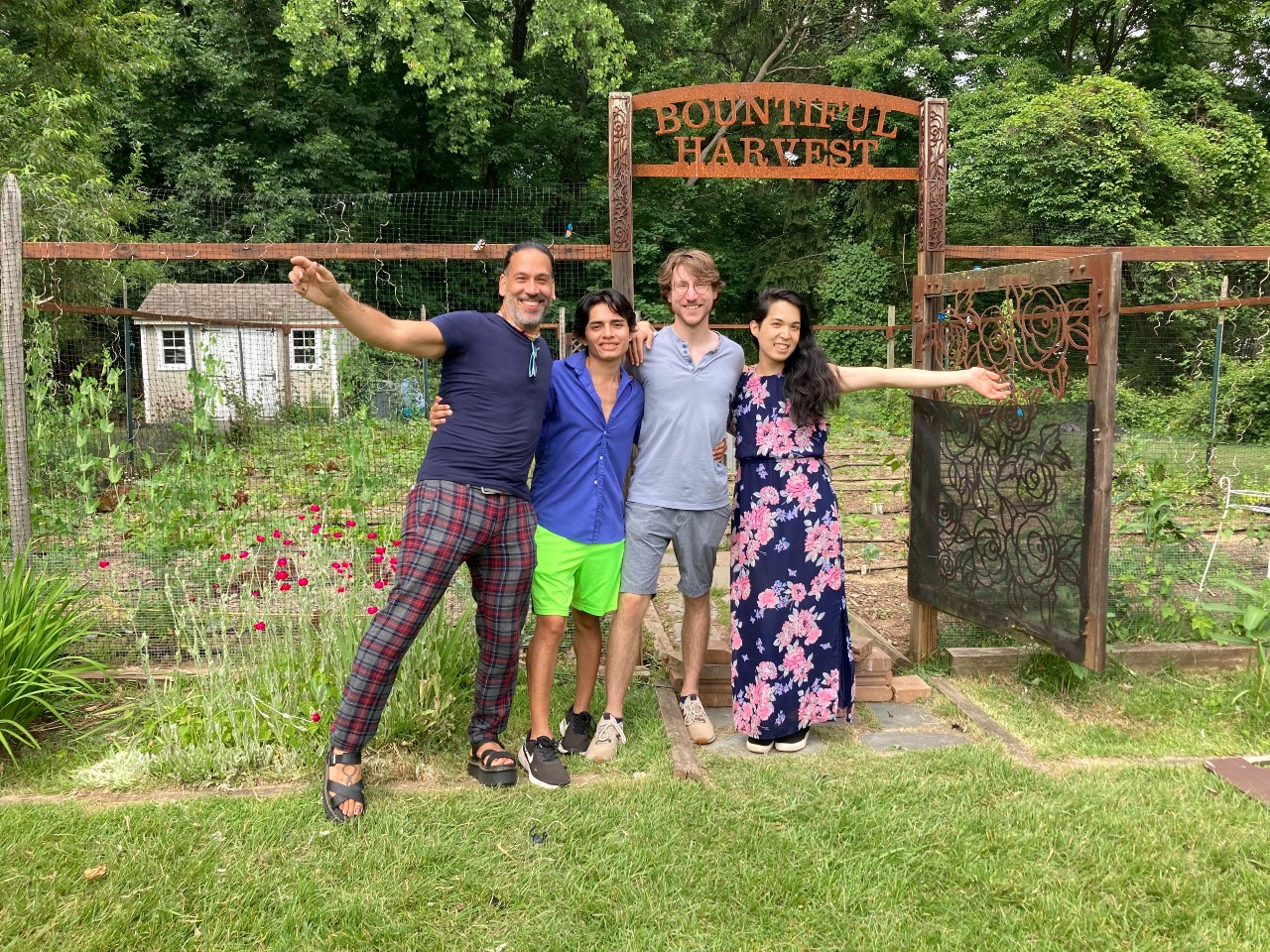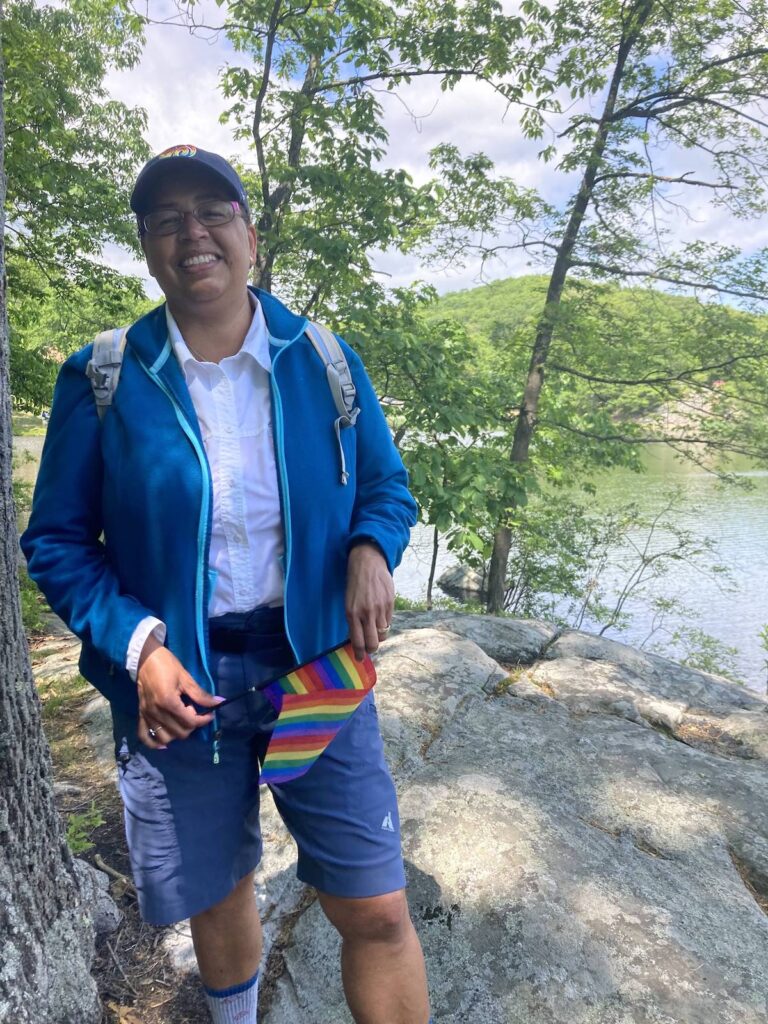
By Reina Gattuso| CivicStory
The NJ Groups Building Intergenerational LGBTQ Community Outdoors
This story was produced with the support of CivicStory and the New Jersey Sustainability Reporting project.
Every summer Sunday in the backyard of a Unitarian Church in Paramus, New Jersey, Bergen County LGBTQ Alliance (BCLA) members meet at a community garden. I visited them on a sunny Sunday in late June. The garden buzzed with life: pea plants climbed the fence, peppers and eggplants sprouted side by side, and quails chatted in a small coop.
“We actually are going back to both environmentalism and queerness to hopefully use garden spaces like this to create a little tea party for everyone,” said Stephen, a BCLA member in their early 20s. Stephen and several other participants chose to use only their first names to protect their privacy. The garden, co-hosted by local food justice organization Common Food for Common Good, provides community space for local transgender and queer people of all ages and backgrounds.
“Having space for being out, visible, is not something that everyone can do,” said Anthony Torres, founder of BCLA. To help address this, New Jersey residents have founded several community-based efforts to support LGBTQ communities in accessing the outdoors. This includes BCLA’s outdoor programming for youth and elders, and the Sierra Club New Jersey Chapter’s LGBT Section, which hosts hiking and environmental education events across the state.
New Jersey is home to both rich natural resources, including outdoor recreation, and staggering environmental injustice.
The state’s LGBTQ communities — who are of diverse ages, orientations, and racial and economic backgrounds— experience particular challenges in accessing the outdoors. Those challenges include high rates of homelessness and a lack of transportation access, economic discrimination, a lack of time for recreation, and safety concerns, especially for transgender people. These fears are intensifying for many amid a rising tide of anti-LGBTQ violence and legislation, with the trans community particularly under threat.
“Everyone deserves to feel like home,” said Stephen. “And if we have spaces like this, at least they can feel that there’s a home waiting.”
LGBTQ Hiking Groups, Then and Now
I accompanied the Sierra Club’s LGBT Section on a hike in Silas Condict County Park in Kinnelon, New Jersey, on a warm Sunday in May 2023. There I met Wanda Ashbrook, the group’s outings chair, alongside a small group of 8 to 10 hikers, mostly older adults.
Ashbrook led the hike, modifying the intensity level to fit everyone’s physical ability. Sunlight filtered through the shifting green leaves and dappled our arms as we walked through the tall, stately trees.
Diane Scarangella, a longtime New Jersey activist in antiwar and environmental movements, revived the dormant LGBT Section in 2022. “I want us to get it together again — especially with all of the things happening around LGBTQ rights and trans rights,” she said.
The first LGBTQ Sierra Club group, the San Francisco Bay Chapter Gay and Lesbian Sierrans, was founded in the Bay Area in 1986. It is still active. That group was one of several independent, gay and lesbian outdoors groups across the country, including New York’s Sundance Outdoor Adventure Society, which was founded in 1980. These groups provided a space for community and healing particularly amid the trauma of the AIDS epidemic.
When Ashbrook came out as a lesbian in Bergen County in the 1990s, she sought community outdoors. But the hiking groups she found were predominantly straight, white, and often majority male. “I didn’t feel safe,” she said.
In the early 2000s, Ashbrook circulated a flier inviting lesbians to join her new hiking group, Lavender Treks. Only one hiker showed up to the first meeting. Yet the group grew steadily, animated by the scrappy attitude of lesbian organizing — a feeling that, “Together, we can make it happen,” Ashbrook said. Lavender Treks hosted hikes and monthly celebrations at New Jersey beaches, where women lounged under the full moon.
Intergenerational Learning
As our feet crunched over the gravel path at Silas Condict County Park in Kinnelon, I chatted with Joe Hoffman. In his 60s, Hoffman volunteers with the Bergen County LGBTQ Alliance. The Sierra Group and BCLA provide him a way to be active, while supporting a younger generation of LGBTQ people. At a recent intergenerational dinner with BCLA, a young person asked him, “Can you be my queer elder?” He laughed good-naturedly. “Yeah!” he responded. “You can ask me anything!”
Many of the LGBTQ people I spoke to said they learned and grew through these intergenerational communities. For many my age — I’m 30 — and younger, our elders provide us a sense of our own history, and show that many different queer life paths are possible. Meanwhile, people in their 50s, 60s, and older said that younger people shared a more expansive sense of gender, and a renewed energy for institutional critique.
“Some of them are rethinking and listening to the young people tell their stories,” said Ashbrook, of her peers. “We’re all growing together.” Recently, Ashbrook says she’s pushed back against transphobia among some Lavender Treks members. This has a broader historical context: some 20th century lesbians and feminists discriminated against transgender people, particularly trans women. Transphobic lesbians and feminists have contributed to the rise in severe, right-wing anti-transgender legislation and violence.
Most lesbians express active support for transgender people’s rights. Moving forward, Ashbrook says Lavender Treks is actively working to become more inclusive, particularly to trans women. Overall, said Ashbrook, she wants to create outdoor spaces that are welcoming to everyone in the LGBTQ community.
Similarly, in the past few years — especially since the Black-led 2020 uprisings against policing and institutional racism — national Sierra Club members have critiqued racism in society at large and within the environmental movement. Today, many Sierra Club members advocate for an environmental justice approach, which centers the intertwined wellbeing of marginalized communities and ecosystems.
Scarangella and Ashbrook said they envision a more social justice-centered Sierra Club. “We’re rewriting the script with rainbow colors, and I want to be part of that,” Ashbrook said.
Growing Community in the Garden
I went to the BCLA community garden in Paramus in late June 2023. Members Nicholas Haas, Stephen and JJ, all in their 20s, gave me a tour alongside director Anthony Torres.
Earlier that week, BCLA had welcomed the Young Scholars, their LGBTQ youth group, which includes homeless youth and youth in foster care. The group made a salad with the garden’s juicy lettuce, fresh kale, and sweet peas.
In caring for the plants, garden participants said, they care for one another. Many people who gather at the garden are transgender and gender-nonconforming. Many have experienced homelessness, criminalization, and severe gender, sexual, racial, and economic discrimination. They may not otherwise have access to green space — or a space free from violence. “The best place to do healing as someone with trauma is the garden,” said Stephen.
The garden provides a safer environment for people to express their identities. “For me as a trans woman, especially when I started transitioning, in the beginning it was always like, ‘What should I wear, what should I not wear?’” JJ said. “When you’re going to a nature thing it’s like, ‘Okay, everyone’s going to kind of wear pants.’ It evens the playing field.”
LGBTQ people in other spaces expressed a similar sense of relief. Abel Saldaña, in his early 30s, has hiked with the Sierra Club LGBT Section. He said that the outdoors provide him a space of serenity. Growing up having to hide his gay identity, “There’s this constant rumination and fear and anxiety,” said Saldaña. In contrast, “Hiking is just the observation of nature and the appreciation and the acceptance of things without judgment,” Saldaña said — including the acceptance of oneself.
“We Fit Perfectly With All the Diversity in the Woods”
Transphobes and homophobes falsely assert that gender diversity and queer sexuality are “unnatural.” In actuality, gender and sexual diversity are the norm among both human and non-human life.
Many LGBTQ activists connect the diversity of the natural world, including sexual diversity, with that of the queer and trans communities. “We join with nature, a colorful and diverse world, when we go on a Sierra Club LGBTQ+ hike. We fit perfectly with all the diversity in the woods,” Ashbrook wrote in a blog post on the Sierra Club website.
Community members argue nature’s diversity should inspire greater social inclusion. “If the world just saw the way I look at plants, and admired each unique diversity, we’d be in a better spot,” said Stephen.
Others said that being outdoors allows them to connect to the vastness of life beyond the human. Outside, Scarangella found “spirituality that has to do with the centeredness of all people.” She saw climate change and environmental degradation as a spiritual wound — one of the reasons she’s active in environmental movements.
Outdoors, Saldaña found an expression of resilience. “I am in awe sometimes outside, just watching the trees sway, wondering how they’re not just falling over,” he said. He was referring to the forest, but he might also have been describing LGBTQ communities. He continued: “And then I remember: they have these massive roots in the ground keeping them down.”
This story was produced with the support of CivicStory and the New Jersey Sustainability Reporting project.

